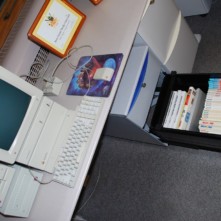Remembering the Apple II
| April 8th, 2013 9:28 AM by Ken Gagne | Filed under Hacks & mods, History, Mainstream coverage; 2 comments. |
A recent CNET story has popularized the unearthing of design schematics for the Disk ][ floppy drive and the contract that outsourced its operating system. This story has been a Big Deal, having been picked up by TUAW, Slashdot, A2Central.com, and others.
This story is also an opportunity to consider the scale and scope of computer history. We Apple II users have gobbled up this news, but I suspect it hasn’t achieved awareness outside the small circles of retrocomputing enthusiasts and computer historians. After all, what relevancy does the Apple II have to the Apple Inc. of today, whose foundation lies not in desktop or even laptop computers, but in cell phones, tablets, and MP3 players?
It wouldn’t be the first time the Apple II has failed to penetrate the public awareness. When I presented the history of the Apple II to the Denver Apple Pi users group, the audience was eager and receptive — with one exception. When one person learned the topic of my speech would be the computer that Apple made before the Macintosh, her response was, "Apple made computers before the Macintosh?" She didn’t see the relevancy in this archaic machine and chose not to stay for the presentation.
Similarly, when I recruited Jason Scott as a guest speaker for my college course, he asked my students the loaded question, "How many of you would agree with me if I said Nintendo is thirty years old?" Nintendo was in fact founded in 1889 and dabbled in many industries, from playing cards to hotels to taxi services, before landing in electronic entertainment. Home video games are just a blip in the timeline of the company that set the standard.
These are just two examples of modern consumers being ignorant or uncaring of the lineage behind their everyday tech. I don’t know that this oversight is necessarily evil so much as it is the product of irrelevance. Is it one we need to change? I would presume that awareness of the existence of pre-Macintosh computers has improved since the passing of Steve Jobs, but my experience is that just as many people as ever respond to my stories of the Apple II with a comment such as "That was my first Mac!"
The Apple II was sold for 16 years, 1977–1993. Sixteen years ago this year, Steve Jobs returned to Apple. That second era has achieved historical notoriety, both for the metaphoric prodigal son’s return and for the reinvention of Apple Computer Inc. as a profitable company. Yet what was long the flagship product of the company’s first 16 years seems to have fallen from public consciousness. Is all tech history susceptible to the vagaries of time? Or is the popularity of computer history directly proportionate the penetration of that era’s computers? Since 1970s computers were not widely adopted by the mass market, is their history similarly of limited appeal? Do we need to improve the Apple II’s public image — not just for the health of our retrocomputing hobby, but for the annals of time? If so, how?
















